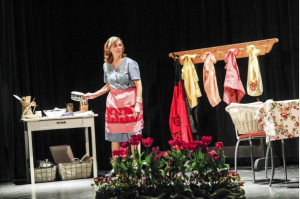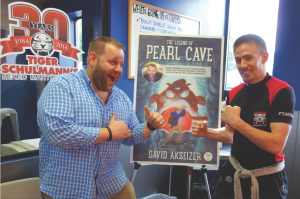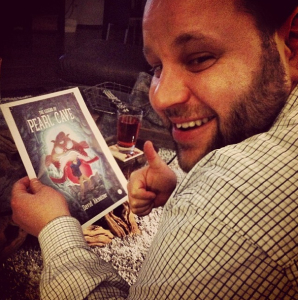By PATRICIA KITCHEN
patricia.kitchen@newsday.com

In “Ada’s Apron,” Deb Rothaug depicts a woman in a South Carolina textile town making breakfast.
It’s hard to imagine what connects a Polish immigrant who starts a Southampton farm stand to a worker in a big-box home improvement store, or a mother pranked by her children on a road trip to Niagara Falls to a woman who loathes the kitchen but cooks up a way to feed her family homemade meals.
The tie that binds them all is a kitchen staple that in the 1950s symbolized the stereotypical American housewife and today is enjoying a resurgence as a fashion trend – the apron.
If aprons the world over could talk, they’d have quite the tale to tell. That was the thinking behind the “Apron Strings Project,” a May production at the Vail-Leavitt Music Hall in Riverhead inspired by a box of aprons dropped off at the doorstep of the historic Longwood Estate in Brookhaven. A collection of 27 poems, songs, scenes and monologues told “the story of women – many different women” through the aprons they wore or might have, and along the way, men’s stories and memories were included, too.
“People connect to the pieces in such deeply personal ways,” said Debbie Slevin, the event’s director, who, with three other Long Islanders, conceived of and produced the show.
Orphan aprons
When a box with three aprons was left anonymously outside the Longwood Estate in 2009, Diane Schwindt, its director, put one of them on that day, and another the next. She has since added to the collection, which now numbers close to 260.
In 2012, the aprons were the focus of an exhibit at the Suffolk County Historical Society Museum in Riverhead, which led to a newspaper article by Slevin, 60, a resident of Hampton Bays and Edgewater, N.J., who saw the glimmer of theatrical potential. At the March 2013 reopening of the Suffolk Theater in Riverhead, Slevin struck up a conversation with local radio host and voice-over artist Cindy Clifford, 59, while they waited in line for popcorn. They continued the friendship, and last fall met for breakfast with photographer Diane Tucci, 44, of Riverhead, and Megan Heckman, 30, a marketing and social media consultant from Eastport. It was there that the “Apron Strings Project” was hatched.
By this time Schwindt’s collection had grown to more than 200 aprons, whose origins and owners were mostly unknown. To give them a backstory, a call went out soliciting tales from writers who could, if they chose, look to a selection of those aprons for inspiration. Submissions were sent in from all over the United States, with two of the estimated 60-plus entries arriving from Canada and New Zealand. They were winnowed down to the 27 in the production. Casting was conducted, and several of the authors were chosen to play the roles in their submissions.
One was Joann Kobylenski Vollmer, 63, who grew up on a farm in Calverton and wrote about her grandmother Jozefa Lewandowska Stachecki, who with her soon-to-be husband emigrated from Poland to America, eventually bought a small farm on David White’s Lane in Southampton, then bought a larger farm and opened the Hampton Vegetable Stand on Montauk Highway. In the production, Jozefa wears a full apron over her housedress and speaks of her nine children, her flowers and vegetables, and how she misses family still in Poland.
On the day in 1926 when she learns that her mother has died, she tells the audience, she cried and cried. “My mother never got to see my children. With my memories buried deep inside my heart, I wiped my tears with my apron, stood up tall and got back to work.”
Schwindt, 54, of Middle Island, mindful of “the most peculiar kind of chain of events” that led to the show, which ran May 2-4, said she was moved while observing audience members’ reactions to various pieces.
“You could see they were remembering, they were flashing back, they got it,” she said.
String of scenarios
One of her favorites was “Niagara Falls,” told from the viewpoint of a grown child reminiscing on the “Canadian caper” in which she and her brothers, cranky over their road trip to Niagara Falls, tell the border guard that the woman at the car’s wheel “isn’t our mother. She’s kidnapped us and we’re scared.” Things get sticky and then are set straight, and ever after, whenever their mother goes to the linen closet and puts on the Niagara Falls apron – “no yelling, almost in slow motion” – they knew that one of them has just crossed the line.
The piece was written by Andrea Rockower, of Yonkers, and performed by Candice DiLavore, 21, of Manorville. She played the role as a punky kid, interrupting her lines to text and answer her phone. The monologue, she said, followed some heavy hitters and was “a nice relief for the audience.”
The aprons in the production ranged from a traditional bibbed-topped piece fit for farm work to a little red number worn by a woman reading magazines and enjoying a few smokes while her next-door neighbor prepares her family’s dinner.
Some of the scenarios were rooted in real life, others were partly or purely fictional, said Clifford, who lives in Riverhead and was one of the show’s producers. The goal, she said, was to elicit varying emotions – sweetness, charm, sadness, loneliness. And when early submissions were on the heavy, serious side, she whipped up “I Hate to Cook,” in which her character turns her grocery money over to her neighbor, a 1950s-type homemaker who loves cooking and aprons and delivers home-cooked meals each night.
“You can only serve TV dinners so many nights in a row before the complaints start,” said the character, played by Dee Martin, 59, of Baiting Hollow.
Of a more complicated nature was “Sister Ruth’s Apron,” a monologue inspired by the sister of its creator, Beverly Rivera Davis, 62, a journalist and author with homes in Des Moines, Iowa, and just outside Woodstock. The character, who says her own mother was “a Spanish immigrant,” speaks of her sister’s marriage to a white man and the apron she wears in an attempt to be “Mrs. Betty Crocker.” Commenting on life’s contradictions, the character said that at any given time, “I may love Ruth’s apron or hate it. She may even love her apron or hate it.”
Dhonna Harris-Goodale, 55, of Flanders, the actress who played the part, said the sister had choices and opted to conform to the lifestyle of June Cleaver, a television character who epitomized the homemaker image of the 1950s. Goodale, also a producer and philanthropist, said she too was not only drawn to Cleaver but occasionally vacuums while wearing high heels and a full black apron with a simulated pearl necklace at the top.
‘A life that goes forward’
Aprons have tugged at others’ imaginations, too. An exhibit titled “Apron Strings: Ties to the Past,” is now at the Kansas City Public Library in Missouri. The aprons inspire “an enormous nostalgic rush,” said Mary Kennedy, chief executive of Mid-America Arts Alliance, whose division manages the traveling show.
“People feel very connected” to the pieces in the exhibit, which highlights the materials and handiwork of their creation as well as their functionality, she added. These days people toss soiled clothing into washing machines, Kennedy said, but aprons were far more necessary back when “doing laundry was much more grueling work.”
The “Apron Strings Project” creators are discussing ways of sharing the vignettes more widely, with ideas ranging from making a version of the script available to various communities to forming a small touring group and taking the show on the road themselves. Of special interest, Slevin said, is including room for a local submission or two to reflect issues and the “special culture” of the area, such as, say, the immigrant flavor in the Southwest.
Vollmer, an herbalist and massage therapist in Thornton, New Hampshire, thinks the project has a future. “I don’t know what, but I feel it has a life that goes forward,” she said.
Its impact on her life has been established. “All through life you have peak experiences, and you go, ‘Wow, that’s a peak experience,’ ” she said. Participating in the production was “a historical marker in my life,” in which her grandmother could “come out and be honored for who she was.”
Click here for the full article.




